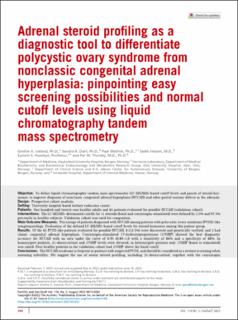| dc.contributor.author | Ueland, Grethe Åstrøm | |
| dc.contributor.author | Dahl, Sandra Rinne | |
| dc.contributor.author | Methlie, Paal | |
| dc.contributor.author | Hessen, Saleh | |
| dc.contributor.author | Husebye, Eystein Sverre | |
| dc.contributor.author | Thorsby, Per Medbøe | |
| dc.date.accessioned | 2023-08-11T12:47:21Z | |
| dc.date.available | 2023-08-11T12:47:21Z | |
| dc.date.created | 2022-09-23T12:36:26Z | |
| dc.date.issued | 2022 | |
| dc.identifier.citation | Fertility and Sterility. 2022, 118 (2), 384-391. | en_US |
| dc.identifier.issn | 0015-0282 | |
| dc.identifier.uri | https://hdl.handle.net/11250/3083628 | |
| dc.description.abstract | Objective: To define liquid chromatography tandem mass spectrometry (LC-MS/MS)-based cutoff levels and panels of steroid hormones, to improve diagnosis of nonclassic congenital adrenal hyperplasia (NCCAH) and other partial enzyme defects in the adrenals. Design: Prospective cohort analysis. Setting: University hospital-based tertiary endocrine center. Patients: One hundred and twenty-one healthy adults and 65 patients evaluated for possible NCCAH (validation cohort). Interventions: The LC-MS/MS-determined cutoffs for 11 steroids (basal and cosyntropin-stimulated) were defined by 2.5% and 97.5% percentile in healthy subjects. Validation cohort was used for comparison. Main outcome measures: Percentage of patients diagnosed with NCCAH among patients with polycystic ovary syndrome (PCOS)-like symptomatology. Evaluation of the defined LC-MS/MS-based cutoff levels for steroid hormones among this patient group. Results: Of the 65 PCOS-like patients evaluated for possible NCCAH, 8 (12.5%) were discovered and genetically verified, and 2 had classic congenital adrenal hyperplasia. Cosyntropin-stimulated 17-hydroxyprogesterone (17OHP) showed the best diagnostic accuracy for NCCAH with an area under the curve of 0.95 (0.89-1.0 with a sensitivity of 86% and a specificity of 88%. In homozygote patients, 21-deoxycortisol and 17OHP levels were elevated, in heterozygote patients only 17OHP (basal or stimulated) was raised. Four healthy patients in the validation cohort had 17OHP above the basal cutoff. Conclusions: The NCCAH syndrome is frequent in patients with suspected PCOS, and should be considered as a routine screening when assessing infertility. We suggest the use of serum steroid profiling, including 21-deoxycortisol, together with the cosyntropin stimulation test with 17OHP. Our data support a 17OHP cutoff of 8.5 nmol/L (2.8 ng/mL) 60 minutes after cosyntropin stimulation, when measured with LC-MS/MS, significantly lower than current European guidelines. Clinical trials number: NCT0218660. Trial registration: ClinicalTrials.gov NCT00218660. Keywords: NCCAH; Nonclassic congenital adrenal hyperplasia; PCOS; infertility; serum steroid profiling. Copyright © 2022 The Authors. Published by Elsevier Inc. All rights reserved. | en_US |
| dc.language.iso | eng | en_US |
| dc.publisher | Elsevier | en_US |
| dc.relation.uri | https://www.clinicalkey.com/#!/content/playContent/1-s2.0-S0015028222003156?returnurl=https:%2F%2Flinkinghub.elsevier.com%2Fretrieve%2Fpii%2FS0015028222003156%3Fshowall%3Dtrue&referrer=https:%2F%2Fpub | |
| dc.rights | Navngivelse 4.0 Internasjonal | * |
| dc.rights.uri | http://creativecommons.org/licenses/by/4.0/deed.no | * |
| dc.subject | NCCAH; | en_US |
| dc.subject | Nonclassic congenital adrenal hyperplasia; | en_US |
| dc.subject | PCOS; | en_US |
| dc.subject | infertility; | en_US |
| dc.subject | serum steroid profiling; | en_US |
| dc.title | Adrenal steroid profiling as a diagnostic tool to differentiate polycystic ovary syndrome from nonclassic congenital adrenal hyperplasia: pinpointing easy screening possibilities and normal cutoff levels using liquid chromatography tandem mass spectrometry | en_US |
| dc.title.alternative | Adrenal steroid profiling as a diagnostic tool to differentiate polycystic ovary syndrome from nonclassic congenital adrenal hyperplasia: pinpointing easy screening possibilities and normal cutoff levels using liquid chromatography tandem mass spectrometry | en_US |
| dc.type | Peer reviewed | en_US |
| dc.type | Journal article | en_US |
| dc.description.version | publishedVersion | en_US |
| dc.rights.holder | Copyright ©2022 The Authors. Published by Elsevier Inc. on behalf of the American Society for Reproductive Medicine. This is an open access article under the CC BY license (http://creativecommons.org/licenses/by/4.0/). https://doi.org/10.1016/j.fertnstert.2022.05.012 | en_US |
| dc.source.pagenumber | 384-391 | en_US |
| dc.source.volume | 118 | en_US |
| dc.source.journal | Fertility and Sterility | en_US |
| dc.source.issue | 2 | en_US |
| dc.identifier.doi | 10.1016/j.fertnstert.2022.05.012 | |
| dc.identifier.cristin | 2054787 | |
| cristin.ispublished | true | |
| cristin.fulltext | original | |
| cristin.qualitycode | 2 | |

